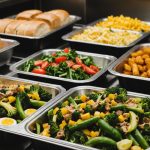Importance of Customer Loyalty in the Restaurant Industry
Understanding customer loyalty’s impact on profitability is vital for any restaurant. Retaining customers is typically more cost-effective than acquiring new ones. According to studies, acquiring new customers can be five times more expensive than retaining existing ones. This is where effective customer retention strategies and restaurant loyalty programs come into play. Emphasising customer experience is crucial in fostering long-term loyalty. Positive dining experiences not only encourage repeat visits but also generate valuable word-of-mouth recommendations.
Customer retention strategies can incorporate various elements, but restaurant loyalty programs are among the most effective. These can range from point-based systems, where customers earn rewards for repeat visits, to highly personalized engagement that tailors offers and experiences based on customer preferences. By focusing on customer experience improvements and leveraging technology, restaurants can create a loyalty program that not only retains customers but also maximizes their lifetime value. Clear objectives, staff training, and evaluation are essential for these programs’ success.
Also to read : Elevating culinary journeys: innovative tactics for restaurants to tailor customer service with data while upholding privacy standards
Ultimately, the goal is to build genuine relationships with diners, ensuring that customers feel valued and appreciated, which enhances their likelihood to return.
Proven Tactics for Enhancing Customer Loyalty
Implementing effective loyalty tactics can significantly enhance customer retention. Actionable insights for restaurants revolve around creating compelling and engaging experiences for diners. A successful measure is the strategic use of point-based rewards programs. These programs allow customers to accumulate points for repeat visits, which can be redeemed for discounts or free items, fostering a sense of accomplishment and loyalty. Implementing tiered rewards can further stimulate frequent dining, as customers strive to reach higher status levels, unlocking exclusive benefits.
This might interest you : Creative ways to repurpose leftovers: effective cost-saving strategies for restaurants to reduce food waste
Incorporating personalized customer engagement is crucial. By utilizing data-driven customer insights, restaurants can tailor offers and experiences to individual preferences, enhancing satisfaction and loyalty. This approach can include targeted promotions or personalized menu recommendations that address customers’ tastes and dietary needs.
Leveraging technology, such as mobile apps, empowers modern loyalty strategies through convenient access to reward trackers and special offers. Email marketing campaigns, when aligned with loyalty incentives, effectively keep customers informed and motivated to participate. Additionally, emerging technologies such as AI-driven chatbots can provide real-time, personalized interactions, augmenting the customer experience. Together, these tactics not only encourage repeat visits but also deepen the emotional connection between the restaurant and its patrons.
Successful Examples of Loyalty Programs in the Restaurant Sector
In the dynamic world of hospitality, some restaurant loyalty programs have set exceptional benchmarks. Starbucks’ Rewards program exemplifies effective implementation, offering customers stars for purchases that unlock exclusive perks. This system encourages repeat visits and boosts customer retention.
Panera Bread’s loyalty initiative demonstrates the power of personalization by tailoring rewards based on purchasing habits, ensuring guests feel recognized and valued. Similarly, Dunkin’s DD Perks program strategically integrates mobile app functionality, streamlining the reward process with effortless access to promotions.
Key elements that contribute to these programs’ success include clear communication of benefits, seamless integration with technology, and ongoing engagement with customers. Building a strong digital presence and offering convenience through mobile apps elevate user experiences and encourage loyalty.
The takeaway here is the imperative of aligning customer incentives with flexible, customer-centric engagement. These cases teach that understanding consumer behaviour and preferences enhances loyalty strategy effectiveness. Restaurants aiming to replicate such success should focus on personalized interactions, tech-savvy approaches, and maintaining a consistent evaluation of program impact for continuous improvement.
Tips for Implementation of Loyalty Programs
In the competitive restaurant sector, implementing successful restaurant loyalty programs requires a well-thought-out strategy. Setting clear objectives is the foundational step in establishing a robust loyalty program. Align these goals with the broader business strategies to ensure coherence and effectiveness. Define specific aims, whether increasing repeat visits or enhancing customer satisfaction, to guide program development and execution.
Next, pay attention to training staff. Encouraging a culture of loyalty within your team can significantly enhance customer participation. Employees who understand and appreciate the loyalty program’s benefits are more equipped to engage diners and promote these advantages. Well-trained staff can be pivotal, as evidenced by various successful case studies showcasing the impact of staff-driven program success.
Ongoing evaluation and improvement are essential. Regular assessments help keep the program relevant and engaging. Analyze customer feedback to identify areas for enhancement and stay informed about new trends to adapt the program accordingly. By focusing on these critical areas, restaurants can build effective, adaptable loyalty programs that foster deeper connections with their customers and drive long-term success.
Measuring the Impact of Loyalty Programs
Understanding customer retention metrics is crucial for evaluating the success of restaurant loyalty programs. These metrics help track the frequency and value of repeat visits, providing clear insights into a program’s effectiveness. For restaurants, precise metrics might include increases in visit frequency, average spend per customer, and the percentage of returning diners. Such quantitative measures allow for the estimation of a customer’s lifetime value (CLV)—a vital metric that identifies the long-term worth of loyal patrons. By focusing on CLV, restaurants can determine which loyalty tactics yield the highest returns.
To refine programs, soliciting and analysing customer feedback is essential. Surveys and direct feedback can reveal customer satisfaction levels and pinpoint areas for enhancement. Engaging diners about their experiences and preferences allows restaurants to adapt their offerings to better meet expectations. This continual dialogue also fosters deeper emotional connections with customers, reinforcing loyalty.
Key performance indicators (KPIs) such as churn rate, customer engagement level, and redemption rates of rewards ought to be regularly monitored. These indicators provide vital information for strategic adjustments, helping to maintain the relevance and appeal of loyalty initiatives over time.











